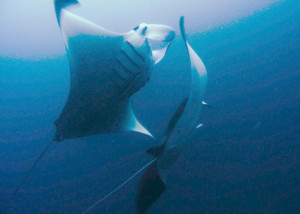Manta rays are ovoviviparous, meaning they produce live young which are hatched from an egg inside the mother.
Like sharks and other rays, mantas are fertilised internally. Male mantas have a pair of penis-like organs called claspers, along the inner part of their pelvic fins. During courtship, males chase the female, eventually grasping the tip of the females pectoral wings in his mouth, and pressing his belly against hers. The male flexes one of his claspers and inserts it into the female’s cloaca, with copulation lasting one to two minutes.

Elaborate courtship dances. Photo courtesy Denise Cottin
Mating occurs in the southern hemisphere from November to January, and in the northern hemisphere from May to June. Mating periods can be identified by observing mating events, courtship behaviour, recent wounds to females wing tips where they have been grasped by males, and swollen and scarred claspers in males. Occasionally mating trains may be seen, with 25 or more males following a single female.
The fertilised eggs develop inside the mother’s body. The pups, wrapped in a thin membraneous egg case, feed on histotrophe, a protein and lipid “milk” secreted by the uterus, until they are fully developed.
Until recently the gestation period was uncertain, with estimates ranging from one to three years. But in June 2007 at the Okinawa Churaumi Aquarium in Japan, a manta was born in captivity for the first time, after a gestation period of one year and nine days.
Birth occurs in shallow water. The pups hatch from their membraneous egg within the mothers oviduct prior to birth. Newborns have a wingspan of between 1.10 to 1.30 m, and are born with the pectoral fins folded over onto themselves. After birth, the wings unfurl. The young will remain in shallow water for several years, before expanding their range offshore.
